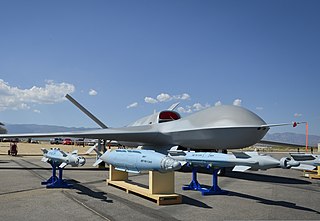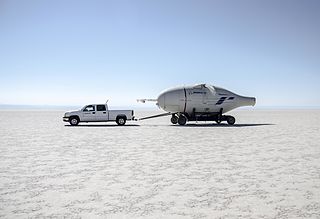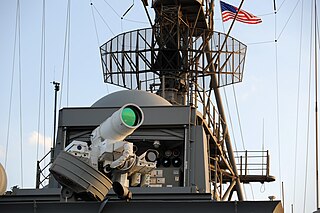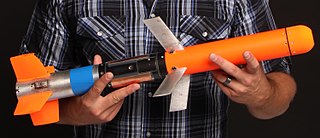Related Research Articles

The Boeing YAL-1 Airborne Laser Testbed weapons system was a megawatt-class chemical oxygen iodine laser (COIL) mounted inside a modified military Boeing 747-400F. It was primarily designed as a missile defense system to destroy tactical ballistic missiles (TBMs) while in boost phase. The aircraft was designated YAL-1A in 2004 by the U.S. Department of Defense.

The Boeing X-45 unmanned combat air vehicle is a concept demonstrator for a next generation of completely autonomous military aircraft, developed by Boeing's Phantom Works. Manufactured by Boeing Integrated Defense Systems, the X-45 was a part of DARPA's J-UCAS project.

The Avenger Air Defense System, designated AN/TWQ-1 under the Joint Electronics Type Designation System, is an American self-propelled surface-to-air missile system which provides mobile, short-range air defense protection for ground units against cruise missiles, unmanned aerial vehicles, low-flying fixed-wing aircraft, and helicopters.

The Advanced Tactical Laser (ATL) program was a US military program to mount a high energy laser weapon on an aircraft, initially the AC-130 gunship, for use against ground targets in urban or other areas where minimizing collateral damage is important. The laser was a 100 kilowatt-class chemical oxygen iodine laser (COIL). It was expected to have a tactical range of approximately twenty kilometres and weigh about 5,000–7,000 kg. This program is distinct from the Airborne Laser, which was a much larger system designed to destroy enemy missiles in the boost phase.
The High Energy Liquid Laser Area Defense System (HELLADS), is a counter-RAM system under development that will use a powerful (150 kW) laser to shoot down rockets, missiles, artillery and mortar shells. The initial system will be demonstrated from a static ground-based installation, but in order to eventually be integrated on an aircraft, the final design would require a maximum weight of 750 kg (1,650 lb) and a maximum envelope of 2 cubic meters (70.6 feet3).
The usefulness of UAVs for aerial reconnaissance was demonstrated to the United States in the Vietnam War. At the same time, early steps were being taken to use them in active combat at sea and on land, but unmanned combat aerial vehicles would not come into their own until the 1980s.

The history of unmanned combat aerial vehicles (UCAVs) is closely tied to the general history of unmanned aerial vehicles (UAVs). While the technology dates back at least as far as the 1940s, common usage in live operations came in the 2000s. UCAVs have now become an important part of modern warfare, including in the Syrian civil war, the 2020 Nagorno-Karabakh war and during the 2022 Russian invasion of Ukraine.

A laser weapon is a directed-energy weapon based on lasers. After decades of R&D, as of January 2020 directed-energy weapons including lasers are still at the experimental stage and it remains to be seen if or when they will be deployed as practical, high-performance military weapons. Atmospheric thermal blooming has been a major problem, still mostly unsolved, and worsened if fog, smoke, dust, rain, snow, smog, foam, or purposely dispersed obscurant chemicals are present. Essentially, a laser generates a beam of light which needs clear air, or a vacuum, to work without thermal blooming.
The GBU-44/B Viper Strike glide bomb was a GPS-aided laser-guided variant of the Northrop Grumman Brilliant Anti-Tank (BAT) munition which originally had a combination acoustic and infrared homing seeker. The system was initially intended for use from UAVs, and it was also integrated with the Lockheed AC-130 gunship, giving that aircraft a precision stand-off capability. The Viper Strike design is now owned by MBDA.

The Agency for Defense Development (ADD) is the South Korean national agency for research and development in defense technology, funded by the Defense Acquisition Program Administration (DAPA). It was established in August 1970 under the banner of the self-reliable defense. Its purpose is contributing to enforcing the national defence, to improving the national R&D capacity, and to fostering the domestic defense industry. ADD focuses on core weapons systems and core technology development, and studies major weapons platforms in high-risk and non-economical fields, unmanned and advanced, and new weapon systems for the future.
The Counter-electronics High Power Microwave Advanced Missile Project (CHAMP) is a joint concept technology demonstration led by the Air Force Research Laboratory, Directed Energy Directorate at Kirtland Air Force Base to develop an air-launched directed-energy weapon capable of incapacitating or damaging electronic systems by means of an EMP.

The General Atomics MQ-20 Avenger is a developmental unmanned combat air vehicle built by General Atomics Aeronautical Systems for the U.S. military.

The Boeing Phantom Eye was a high altitude, long endurance (HALE) liquid hydrogen-powered unmanned aerial vehicle developed by Boeing Phantom Works. The aircraft was Boeing's proposal to meet the demand from the US military for unmanned drones designed to provide advanced intelligence and reconnaissance work, driven by the combat conditions in Afghanistan in particular. In August 2016, the Phantom Eye demonstrator was disassembled for display at the Air Force Flight Test Museum.

The Vestel Karayel is a surveillance, reconnaissance and later combat unmanned aerial vehicle system developed by Vestel. The drone is currently operated by Turkish Armed Forces and the Armed Forces of Saudi Arabia.

Martlet is a lightweight air-to-surface, surface-to-air, and surface-to-surface missile developed by Thales Air Defence for the United Kingdom. It is named after a mythical bird from English heraldry that never roosts, the martlet.

The AN/SEQ-3 Laser Weapon System or XN-1 LaWS is a laser weapon developed by the United States Navy. The weapon was installed on USS Ponce for field testing in 2014. In December 2014, the United States Navy reported that the LaWS system worked perfectly against low-end asymmetric threats, and that the commander of Ponce was authorized to use the system as a defensive weapon.
Iron Beam, officially מגן אור, magen or, "Light Shield", is a directed-energy weapon air defense system which was unveiled at the Singapore Airshow on February 11, 2014 by Israeli defense contractor Rafael Advanced Defense Systems. The system is designed to destroy short-range rockets, artillery, and mortar bombs; it has a range of up to 7 km (4.3 mi), too close for the Iron Dome system to intercept projectiles effectively. In addition, the system could also intercept unmanned aerial vehicles (UAVs). Iron Beam will constitute the fifth element of Israel's integrated air defense system, in addition to Arrow 2, Arrow 3, David's Sling, and Iron Dome. However, Iron Beam can be used stand-alone.

The Defense Acquisition Program Administration (DAPA) is an executive branch of the South Korean government that was established on January 1, 2006 under the Ministry of National Defense to administer improvement projects of defense capability, the procurement of munitions, and the fostering of defense industries.

The Spike, also called the Forward Firing Miniature Munition (F2M2), is a small missile developed by the USA Naval Air Warfare Center Weapons Division (NAWCWD), NAVAIR's Weapons Division.
A loitering munition is an aerial weapon system category in which the munition loiters around the target area for some time and attacks only once a target is located. Loitering munitions enable faster reaction times against concealed or hidden targets that emerge for short periods without placing high-value platforms close to the target area, and also allow more selective targeting as the attack can easily be aborted.
References
- ↑ Truck-mounted laser shoots down spy drone - tech - 27 January 2009 - New Scientist
- ↑ "Boeing: Boeing Laser Avenger Shoots Down Unmanned Aerial Vehicle in Tests". Archived from the original on 2010-01-18. Retrieved 2010-01-27.
- ↑ Boeing Tests Avenger Solid State Laser Weapon Archived February 1, 2010, at the Wayback Machine